Students can Download 1st PUC Biology Model Question Paper 2 with Answers, Karnataka 1st PUC Biology Model Question Papers with Answers helps you to revise the complete Karnataka State Board Syllabus and score more marks in your examinations.
Karnataka 1st PUC Biology Model Question Paper 2 with Answers
Time: 3.15 Hours
Max Marks: 70
General Instructions:
- The question paper consists of four parts A, B, C and D.
- All the parts are compulsory.
- Draw diagrams wherever necessary. Unlabelled diagrams or illustration do not attract any marks.
Part – A
Answer the following questions in one word or one sentence each: ( 10 x 1 = 10 )
Question 1.
Define a Taxon.
Answer:
Any unit of classification is called taxon
Question 2.
Who proposed Binomial Nomenclature?
Answer:
Carolus Linnaeus
Question 3.
Define aestivation.
Answer:
Mode of arrangement of sepals or petals in floral bud with respect to the other members of the same whorl.
Question 4.
What is open type of vascular bundle?
Answer:
If cambium is present between phloem and xylem.
![]()
Question 5.
Name the cell which stores fat?
Answer:
Adipose cell.
Question 6.
In which muscular tissue intercalated discs are found?
Question 7.
Name the stage of cell cycle where DNA replication takes place?
Answer:
Interphone or S-Phase of Interphase.
Question 8.
Define Guttation
Answer:
Loss of water in the form of liquid droplets through water stomata.
Question 9.
What is hydroponics?
Answer:
Technique of growing plants in a nutrient solution.
![]()
Question 10.
Define lymph.
Answer:
The fluid present lymphatic system.
Part – B
Answer any FIVE of the following questions in 3 – 5 sentences each, wherever applicable:( 5 x 2 = 10 )
Question 11.
Write a note on Herbarium.
Answer:
Herbarium is a store house of collected plant specimens that are dried and preserved on sheets.
The herbaria serve as quick referral systems in taxonomic studies
Question 12.
Diagram a Labeled diagram of Nostoc Filament.
Answer:
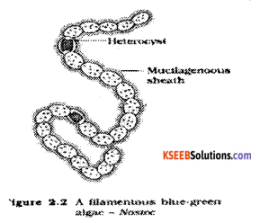
Question 13.
Give any Two economic importances of algae.
Answer:
- Half of the total carbon dioxide fixation on earth is carried out by algae and they increase the level of oxygen in their environment.
- Many species of algae are used as food.
![]()
Question 14.
Differentiate between chordates and non chordates
Answer:
| Chordates | Non Chordates |
| 1. Notochord is present | 1. Notochord is absent |
| 2. Dorsal, hollow tubular nerve cord | 2. Ventral, solid double nerve cord |
| 3. Gill slits present | 3. Absent |
| 4. Heart is ventral | 4. Ventral |
| 5. Post anal tail present | 5. Absent |
Question 15.
What are long day and short day plants?
Answer:
- Long day plants- Plants require more light period than the critical duration
- Short day plants- Plants require light period lesser than the critical duration.
Question 16.
Define Inspiration and Expiration
Answer:
- Inspiration- Entry of atmospheric air into the lungs
- Expiration- Exit out of air from lungs to atmosphere.
Question 17.
Mention two contractile proteins
Answer:
- Actin
- Myosin
![]()
Question 18.
Name any two types of movements.
Answer:
- Amoeboid
- Ciliary
- Muscular movements
Part – C
Answer any FIVE of the following questions in 40 – 80 words each, wherever applicable: ( 5 x 3 = 15 )
Question 19.
Enumerate any three characters of Pteridophytes.
Answer:
- Terrestrial
- conducting tissue Xylem and phloem
- Plant body is Sporophyte
- It is differentiated into true roots, stem and leaves.
- Leaves are small or large.
- Sporophyll produces sporangia.
- Gametophyte is called prothallus.
- Sex organs are antheridia and archegonia.
- Heterosporous or Homosporous.
Question 20.
What is phyllotaxy? Mention any two types.
Answer:
The arrangement of leaves on the stem
- Alternate
- Opposite
- Whorled Mention any
![]()
Question 21.
Labeled diagram of Collenchyma.
Answer:
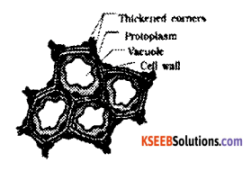
Question 22.
Mention one function of each
a) Ribosome,
b) Endoplasmic reticulum,
c) Golgi apparatus.
Answer:
a) Ribosome- Protein synthesis
b) Endoplasmic Reticulum- Lipid synthesis or protein synthesis.
c) Golgi apparatus- Packing material or Formation of glycoproteins or Lipids.
Question 23.
Write any three differences between Mitosis and Meiosis.
Answer:
| Mitosis | Meiosis |
| 1. Equational division | 1. Reductional |
| 2. Occurs in somatic cells | 2. Reproductive cells |
| 3. Single division | 3. Double division |
| 4. Separation of chromatids in metaphase | 4. Separation of chromatids in homologous chromosomes in metaphase. |
| 5. Prophase is of shorter duration | 5. Longer duration |
| 6. Formation of 2 cells | 6. 4 cells |
| 7. Synapsis, Crossing over and Recombination do not take place during prophase. | 7. All these takes place in prophase – I |
| 8. Karyokinesis is followed by cytokinesis | 8. Interkinesis is followed by prophase – II |
![]()
Question 24.
List any three physiological roles of Cytokinins.
Answer:
- It produce new leaves
- It produce chloroplasts in leaves
- overcome apical dominance
- Promote lateral shoot growth
- Delay senescence
Question 25.
Define. a)Ammonotelism b)Ureotelism.c)Uricotelism.
Answer:
a) Ammonotelism- Excrete ammonia
b)Ureotelism- Excrete Urea
c) Uricotelism- Excrete uric acid
Question 26.
Mention the formed elements of Blood
Answer:
- RBC or Erythrocytes
- WBC or Leucocytes
- Platelets or Thrombocytes
Part – D
Section – I
Answer any FOUR of the following questions in 200 – 250 words each, wherever applicable: ( 4 x 5 = 20 )
Question 27.
Write the salient features of the phylum Arthropoda.
Answer:
- Organ system level of organization
- Bilaterally symmetrical
- Triploblastic
- Segmented body
- Body is divisible into head,thorax and abdomen
- Jointed appendages
- Respiratory organs- gills,book gills,book lungs or tracheal systems
- Circulatory system- open
- Body cavity- haemocoel
![]()
Question 28.
Explain Fluid Mosaic Model with labelled diagram.
Answer:
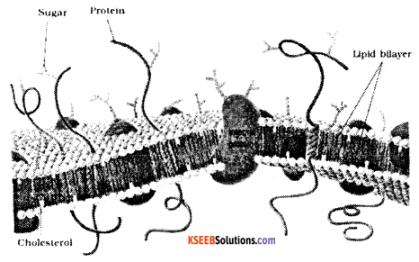
- Cell memberane is composed of lipids,arranged in by layers
- Lipids has polar head and non polar tail
- It possess proteins and carbohydrates
- proteins are intrinsic or extrinsic
- Integral proteins partially totally buried in the memberane points
Question 29.
Write the functions of the following proteins a) Collagen b) trypsin c) Insulin d) antibody e) receptor protein.
Answer:
a) Collagen-inter cellular ground substance
b) Trypsin- Enzyme
c) Insulin- Hormone
d) Antibody- Fight against microbes
e) Receptor- Sensory
Question 30.
Explain Mass flow hypothesis.
Answer:
- The mechanism used for the translocation of sugar from source to sink end is called pressure flow or mass flow.
- Glucose converted into sucrose then moved into the companion cells and then to sieve tube cells of phloem.
- This process of loading at the source form the hypertonic condition in the phloem.
- Water from the adjacent xylem moves into the phloem by osmosis. Osmotic pressure builds up in the phloem sap moves to area of lower pressure.
- At the sink osmotic pressure must be reduced. The movement of sugar in the phloem begins at the source, where sugars are loaded into a sieve tube.
- Loading of phloem set up a weaker potential gradient that facilitates the mass movement in the phloem. As hydrostatic pressure increased in the sieve tube, pressure flow begins and the sap moves through the phloem. Mean while at the sink incoming sugars are actively transported out of the phloem. The loss of solute reduces a high water potential in the phloem and water passes out returning eventually to xylem.
Question 31.
Explain the development of root nodules in Soyabean.
Answer:
- Nodule formation involves a sequence of multiple interactions between Rhizobium and roots of the host plant.
- Rhizobium bacteria contact a susceptible root hair, Divide near it.
- Upon successful infection of the root hair cause it to curl.
- Infected thread carries the bacteria to the inner cortex. The bacteria get modified into rod shaped bacteroids and cause inner cortical and pericycle cells to divide. Division and growth of cortical pericycle cells lead to nodule formation.
- A mature nodule is complete with vascular tissues continues with those of the root.
![]()
Question 32.
Write the Z scheme of light reaction.
Answer:
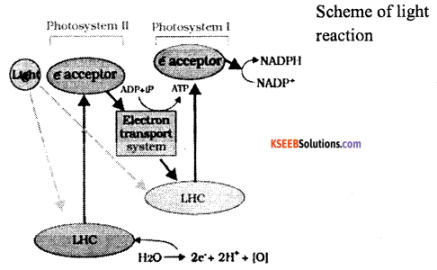
Part – D
Section – II
Answer any THREE of the following questions in 200 – 250 words each, wherever applicable: ( 3 x 5 = 15 )
Question 33.
Draw a labeled sketch of Digestive system of cockroach
Answer:
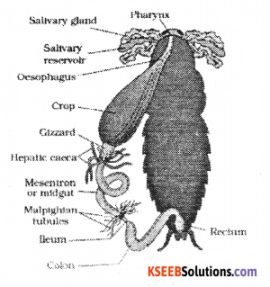
Question 34.
Schematic representation of Krebs cycle (Citric Acid Cycle)
Answer:

![]()
Question 35.
Mention any five hormones of anterior pituitary.
Answer:
- Growth Hormone
- Prolactin
- Thyroid Stimulating Hormone
- Adreno Corticotropic Hormone
- Luteinizing Hormone
- Follicle Stimulating Hormone
- Melanocyte Stimulating Hormone
Question 36.
Name the divisions of Human neural system. Explain the components of each division.
Answer:
1. Central Nervous System
a) Brain
b) Spinal cord
2. peripheral Nervous System
a) Somatic Nervous System
b) Autonomic Nervous System
i)Sympathetic
ii) Parasympathetic
![]()
Question 37.
a) Name disaccharide digesting enzymes found in the intestinal juice.
Answer:
- Sucrase
- Maltase
- Lactase
b) What is oxygen dissociation curve? Write its significance.
Answer:
Definition-A Sigmoid Curve is obtained when percentage saturation of Hemoglobin with oxygen is plotted against the partial pressure of oxygen.
Significance- It is useful in studying the effect of factors like partial pressure Of carbon dioxide, proton concentration on binding of oxygen with Hemoglobin.